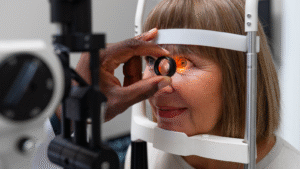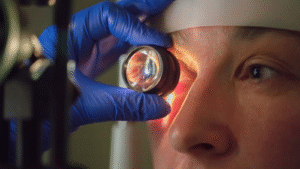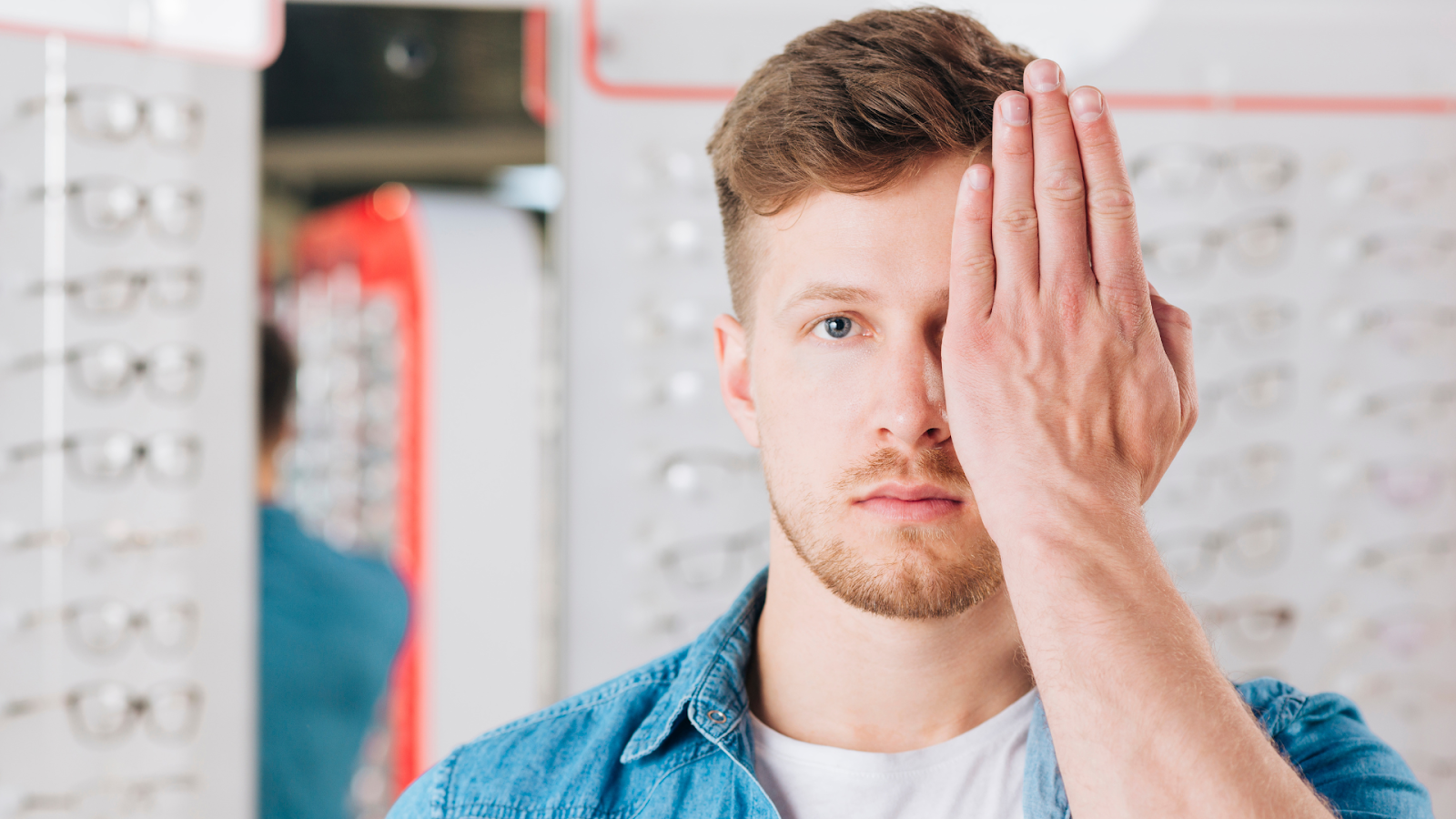Surfer’s eye, also known as pterygium, is a common eye condition affecting millions worldwide, particularly those exposed to prolonged sunlight, wind, or dust. While often associated with surfers, it can impact anyone. This growth on the eye’s surface may start as a cosmetic issue but can impair vision if untreated.
According to research, a pterygium may recur in up to 10% (one in ten) cases, typically within the first year after surgery. Repeat surgery may be required. Early detection and proper care are key to preventing vision damage and maintaining eye health.
This guide offers a clear understanding of surfer’s eye, helping you recognise early signs and seek timely care to protect your eye health.
Key Takeaways
- Surfer’s eye is caused by UV exposure, wind, and dust, which are common in people who spend a lot of time outdoors.
- Watch for early signs like redness, irritation, and a visible growth near the nasal side of the eye.
- Mild cases can be managed with eye drops and UV protection; surgery is necessary if it affects vision or recurs.
- An eye exam is usually enough to diagnose it and check how much the growth impacts your vision.
- Prevent it by wearing sunglasses, avoiding irritants, and getting your eyes checked if anything looks or feels off.
What is a Surfer’s Eye?

Surfer’s eye, or pterygium, is a non-cancerous growth of fleshy tissue on the conjunctiva, typically starting near the nasal side of the eye. It appears as a raised, reddish bump on the sclera, often associated with environmental factors such as UV light, wind, and exposure to saltwater.
Common in surfers, this condition progresses slowly, and while it is painless, it may cause irritation or a gritty feeling. In some cases, it can extend onto the cornea. It can affect one or both eyes and is most common in people with prolonged outdoor exposure.
Causes and Risk Factors
Surfer’s eye develops due to chronic environmental irritation, with prolonged exposure to specific risk factors triggering changes in the conjunctiva.
- UV Light Exposure: UV rays from the sun damage the conjunctiva and cornea, leading to abnormal cell growth. People in sunny or high-altitude areas, athletes, and those with fair skin are at higher risk.
- Wind and Dust: Wind dries the eye surface, disrupting the tear film, while dust and airborne particles worsen irritation and promote tissue growth.
- Saltwater Irritation: Saltwater can inflame the eyes and lead to abnormal tissue growth, which is common among surfers, swimmers, and coastal workers.
- Genetics: Some people inherit a higher susceptibility to surfer’s eye, with certain families showing a higher incidence.
- Age and Other Factors: Adults aged 20 to 50 are most affected, but the condition can occur at any age. Chronic exposure to chemicals, smoke, or poor hygiene can increase risk.
Surfer’s eye is caused by environmental exposures and genetic susceptibility, with UV radiation being the primary driver.
Must read: Pterygium Surgery Procedure and Recovery Guide
Signs and Symptoms
Surfer’s eye often begins subtly and progresses gradually, making early recognition important.
Here are common signs and symptoms to watch out for:
- Visible Growth: A pink or reddish triangular growth on the white part of the eye, often near the nose, which enlarges over time.
- Eye Redness: Persistent redness around the affected area, making the eye look bloodshot.
- Irritation: A gritty or sandy sensation in the eye, especially in windy or dry conditions.
- Excessive Tearing: Increased tear production as a response to irritation.
- Blurred Vision: If the growth extends onto the cornea, it can cause blurred or distorted vision.
- Dryness or Burning: A dry or burning sensation due to tear film disruption and inflammation.
- Swelling: Swelling and tenderness during flare-ups.
When to See a Doctor
Consult an eye care professional if you experience persistent redness, growth, irritation, or changes in your vision, especially after frequent outdoor exposure.

If symptoms escalate, consulting with experienced ophthalmologists, such as Mr. Hatch Mukherjee at The Vision Surgeon, can help determine the best course of action for your eye health.
Diagnosis of Surfer’s Eye
Diagnosing surfer’s eye is a straightforward process carried out by an ophthalmologist or optometrist through a comprehensive eye exam.
- Visual Inspection: The exam is painless and takes just a few minutes, using a slit-lamp microscope to assess surface changes and rule out other conditions.
- Assessment of Growth Extent: The doctor measures the extent to which the pterygium extends onto the cornea and checks if it affects the central visual axis.
- Evaluation of Vision Impact: Tests are done to see if the growth distorts the cornea or causes astigmatism.
- Differential Diagnosis: The doctor rules out similar conditions, such as pinguecula, conjunctivitis, or ocular surface tumours.
- Additional Tests: Advanced imaging or biopsy may be necessary if the growth exhibits unusual features or rapid progression.
Early diagnosis enables timely management, which can prevent the progression of growth and associated complications.
Also read: Understanding PRK Eye Surgery and Its Process
Non-Surgical Treatments

For mild to moderate cases of surfer’s eye, non-surgical approaches aim to relieve symptoms, reduce inflammation, and prevent further growth. These treatments do not remove the existing growth but help manage discomfort.
- Artificial Tears and Lubricants: Preservative-free drops restore moisture and relieve dryness, especially in dry or windy conditions.
- Anti-Inflammatory Eye Drops: Prescription drops containing corticosteroids or NSAIDs can help reduce redness and swelling during flare-ups; use under the guidance of a medical professional.
- UV Protection: Sunglasses blocking 100% of UVA and UVB rays protect the eyes and slow the progression of surfer’s eye.
- Protective Measures Against Irritants: Limit exposure to wind, dust, smoke, and saltwater. Use protective eyewear and wide-brimmed hats outdoors.
- Regular Monitoring: Routine eye exams track growth and prevent potential vision issues.
Non-surgical treatments are best suited for cases where the growth is small, asymptomatic, or only mildly irritating.

Consulting a specialised clinic like The Vision Surgeon can ensure you receive tailored advice on managing and treating surfer’s eye with the latest advancements in eye care.
Surgical Treatment Options
Surgical removal of a surfer’s eye is recommended if it threatens vision, causes discomfort, or leads to cosmetic concerns. The goal is to remove the abnormal tissue and restore the eye’s surface.
- Pterygium Excision: The fibrovascular growth is removed under local anaesthesia in about 20-30 minutes with minimal pain during and after surgery.
- Conjunctival Autograft: A healthy part of the eye’s conjunctiva is transplanted to reduce recurrence after excision. This promotes healing and prevents regrowth.
- Amniotic Membrane Transplant: For larger or recurrent pterygia, an amniotic membrane graft is used to aid healing, reduce inflammation, and minimise scarring.
- Adjunctive Therapies: Anti-metabolite agents, such as mitomycin C, may be used to prevent recurrence by inhibiting the growth of fibroblasts.
- Postoperative Care: Patients use antibiotic and anti-inflammatory eye drops for several weeks, along with protective eyewear and sun avoidance, to aid in recovery.
Surgical Outcomes and Recurrence: While surgery yields excellent results, recurrence is a possibility, especially when proper UV protection and ongoing care are not followed.
Conclusion
Surfer’s eye is a condition caused by prolonged exposure to UV rays, wind, and irritants. It can lead to discomfort and vision issues if left untreated. Mild cases can be managed with non-surgical treatments, but advanced cases may require surgery.
To prevent it, wear UV-blocking sunglasses, avoid irritants, and seek medical advice if you notice eye redness or unusual growths. Early intervention ensures better outcomes and long-term eye health.
Surfer’s eye isn’t dangerous, but it can lead to long-term discomfort, vision changes, or cosmetic concerns if ignored. With proper care, most cases are manageable. If symptoms persist, early specialist input helps avoid complications. The Vision Surgeon specialises in delivering advanced eye care solutions tailored to your needs.
If you’re based in Essex, Colchester, or surrounding areas and are seeking expert care for surfer’s eye or any other eye condition, schedule your consultation today.
FAQs
1. What is Surfer’s Eye?
A non-cancerous growth on the eye’s conjunctiva caused by UV light, wind, or saltwater exposure. It can cause irritation and may affect vision if left untreated.
2. What are the symptoms?
Redness, a gritty or dry feeling, blurred vision, and a visible growth on the white part of the eye.
3. How is it diagnosed?
Through an eye exam using a slit-lamp microscope to check the size and impact of the growth.
4. Can it be treated without surgery?
Yes, mild cases can be managed with lubricating drops, anti-inflammatory medication, and UV protection.
5. When is surgery needed?
If the growth causes discomfort, affects vision, or keeps growing, surgical removal is recommended.
6. How can I prevent it?
Wear sunglasses that block UV rays and avoid long-term exposure to wind, dust, and saltwater.
